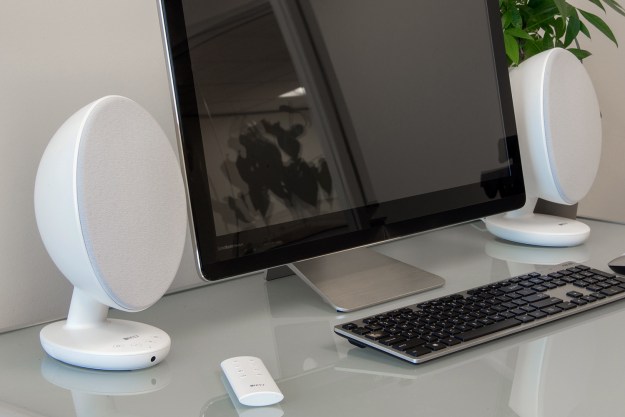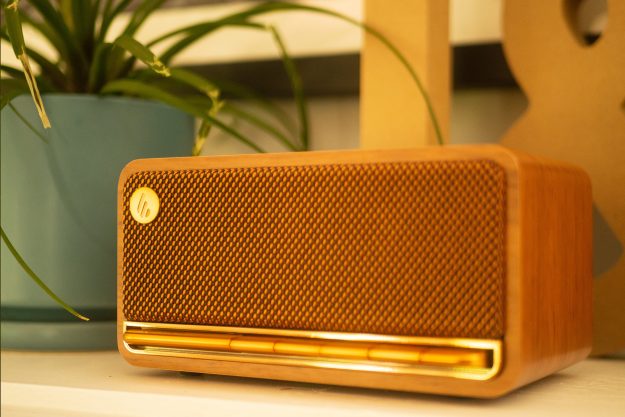
- Deep soundstage, excellent imaging
- Immaculate sound quality
- Wide stereo separation
- Digital, analog, and Bluetooth connectivity
- High-res audio playback
- Pricey
- Limited length, proprietary speaker cable
Buying speakers was a lot simpler back when our entertainment was neatly compartmentalized. You bought home stereo speakers and a receiver for your living-room needs, perhaps a separate system for your kitchen or bedroom, computer speakers for your office, and so forth. But today, those lines are blurring. Your computer, smartphone, and tablet probably get as much facetime as your TV, and speaker systems that connect to just one seem antiquated.
Can you really get just one speaker system — the best speaker system — that fulfills multiple needs? British speaker maker KEF thinks so. It might be hard to imagine how the KEF Egg digital wireless speaker system would make a better choice than a portable Bluetooth speaker or multiroom wireless system, but you’d be surprised to learn how well it fits just about everywhere. Connect them to your TV, your computer, or just place them in a room where you want music – they’re a killer little set of speakers.
In a world where music comes from our smartphones instead of our CD rack, the KEF Egg make a lot of sense, and they sound great doing it, too.
Out of the box
KEF charges a premium price for what look like a simple pair of computer speakers. At $500 for the rig, you’re paying as much for KEF’s audio engineering as you are the Egg’s versatility. But if you’re one who values premium build and sound, the Egg offer a very nice return on your investment, and you feel that as soon as you pull them from their box.
The Egg (Eggs?) are heavy little speakers, a fact owed to their stout, anti-resonant cabinets and premium components inside. Outside, each speaker sports a matte finish (available in white, blue and black) that looks classy and should stay that way since they buck fingerprints so well. Even the unusually heavy remote control exudes an air of class you don’t often get with such a typically utilitarian accessory.
In the box you’ll find a power brick with a sufficiently long power cable, high-quality USB cable, optical cable, and the aforementioned remote. If you want to connect any device with an analog input, you’ll need to furnish your own 3.5mm cable, as the Egg system doesn’t come with one.
Features
As a fully self-contained speaker system, the Egg comes with both a high-quality 24-bit/96kHz DAC capable of playing back many high-resolution digital audio files, and a 50-watt digital amplifier, all built right in. The USB connection will be useful when connecting to a desktop or laptop computer, while the digital optical/3.5 mm hybrid jack allows digital connections to televisions and analog connections to nearly anything else you can think of.
For streaming, the Egg offers a Bluetooth 4.1 wireless connection with aptX decoding for devices that support the codec.
If any speaker could make Nate Dogg and Warren G sound classy while they regulate, then I suppose it’s the KEF Egg.
Under each speaker’s removable grill is KEF’s patented Uni-Q point-source driver array, which puts the tweeter right in the center of the midbass driver. This coaxial design comes with several benefits, not the least of which is coherency – in other words, all of the frequencies are coming from one place, keeping them very tightly in line with each other, thus making for a unified sound. Another benefit of KEF’s Uni-Q design is very realistic imaging and sound staging – something we’ve found plays out at a much grander scale when you move into some of KEF’s larger Uni-Q speakers.
With the Egg system, the right speaker plays master and commander while the left speaker acts as a sort of slave. All of the Egg’s guts and inputs/outputs are built into the clearly marked right channel. The left speaker has a stout speaker cable terminated with a four-pin plug that connects to the rear of the right speaker.
For management, the left speaker cable can be wound and tucked into its base … to a point, anyway. There will always be about 1.5 feet of cable left dangling. The cable does extend to nearly five feet, but considering how large the Egg speakers can sound, we almost wish it went a bit longer for even more stereo separation.
If you want to add a subwoofer, the Egg accommodates with a built-in subwoofer output jack. KEF makes a very nice line of subwoofers (we’d recommend the Kube 1), but any subwoofer of respectable quality would work as well.
Performance
I invariably get asked for purchasing advice on a wide range of audio and video products, but recently, I’m getting asked a lot more questions about computer speakers. It turns out, many people are buying big monitors and converting their computers from mere email and Web surfing machines to full-blown entertainment systems. This tells me that speakers like the KEF Egg have a potential audience. But when I bring up the Egg in conversation, the price tends to be a little … off-putting. I think that’s because folks usually think of computer speakers as relatively inexpensive packages that come with subwoofers that make a lot of boom. It’s true, those inexpensive systems will make a good deal of boom, but not a whole lot else. Dialog tends to sound chunky, sound effects are often too loud, and, musically speaking, well … there’s just not much to get excited about.
The KEF Egg is none of those things, and everything those speaker systems never could be. It is refined, poignant, crystal clear, punctual, and straight-up luxurious. Also, the Egg sounds far larger than it has any right to.
I started my listening session with electro-pop duo, Bird and the Bee, and the cut Please Take Me Home from their latest record, Recreational Love. This tune is full of washing stereo synthesizer sounds, a pure, up-front vocal with just a touch of reverb, and some sustained, low bass pulses that will test the tightness of any speaker’s bass prowess. In short: I loved the way the Egg treated the song. Top to bottom, the Egg system speakers remained faithful to the track’s contents without adding anything or taking anything away. Bass was taught, tuneful and well-weighted, the midrange – especially the upper mids – were startlingly clear, and the treble was beautifully rendered with gobs of inner detail and sparkle, and just enough dryness around sibilants to sound realistic but avoid offending. Wow. I could have stopped here, but where’s the fun in that?
My next track was unapologetically bass-heavy. I thought I had heard something of a buzz in the prior track, but had trouble nailing down the source. Playing Regulate by Warren G didn’t help me bring the buzz back (it only happened at one particular frequency, and this track wasn’t activating it) but it did show me the limits of the Egg’s bass capabilities, which went further than I had expected. If any speaker could make Nate Dogg and Warren G sound classy while they regulate, then I suppose it’s the KEF Egg. And the fact the speakers were clearly getting down to 55Hz with some authority was all the more impressive.
In a world where music comes from our smartphones instead of our CD rack, the KEF Egg makes a lot of sense.
That buzz kept bugging me though, so I pulled up a tone generator and started doing frequency sweeps until I nailed it down. It turned out that I had reached the perfect combination of sound pressure level and low frequency to cause the Uni-Q driver to flap against the grill in front of it. Once I removed the grill, it was done. KEF assures me this is not a noted problem, and possibly unique to my set of speakers. I say it’s nothing too big to worry about. Even if it is an issue inherent to the speaker design (doubtful) the buzz is hard to perceive unless you are actively seeking it out.
As for performance with my TV, the Egg was limited only by the quality of signal it received. Some programming simply sounded unimpressive, yet the experience was far and away better than what I got from my Panasonic plasma’s on-board speakers. If only for stereo separation and enhanced dialog clarity, the Egg make a lot of sense as a supplemental TV sound solution.
Conclusion
The DT Accessory Pack
Up your game and the get the most out of your gear with the following extras, hand-picked by our editors:
ASUS Zenbook UX305FA 13.3 Inch laptop ($699)
Samsung 55-Inch 4K Ultra HD Smart LED TV ($1298)
Sony Walkman 64 GB Hi-Res digital music player ($298)
Part of the excitement the Egg imparts is the unexpected scale of its soundstage and the brilliant effect of its stereo separation. It is excels in almost every aspect at which even the most advanced one-box speakers fail. And underscoring it all is KEF’s unmistakable, impeccable sound signature.
Those are all great things, but they are things that I think will only appeal to those who are very serious about sound quality. Fortunately, those are the same sort of folks who won’t balk at the notion of $500 for such a versatile speaker system.
So, while I have no reservations whatsoever about giving the KEF Egg my full, unfettered recommendation (and an Editor’s Choice badge,) I do so with the desire that the reader understand I know this system isn’t for everyone. Though, I will say, once you hear it, you may not be able to accept anything else for your multimedia needs. The Egg is just that good.
Highs
- Deep soundstage, excellent imaging
- Immaculate sound quality
- Wide stereo separation
- Digital, analog, and Bluetooth connectivity
- High-res audio playback
Lows
- Pricey
- Limited length, proprietary speaker cable
Editors' Recommendations
- Samsung Music Frame hands-on: invisible audio done right
- KEF launches a more affordable version of its coveted LSX II bookshelf speakers
- Tivoli Audio’s Model Two Digital speaker abandons terrestrial radio
- What is Sonos? What you need to know about the wireless music system
- NAD’s CS1 adds wireless streaming music to any audio system









